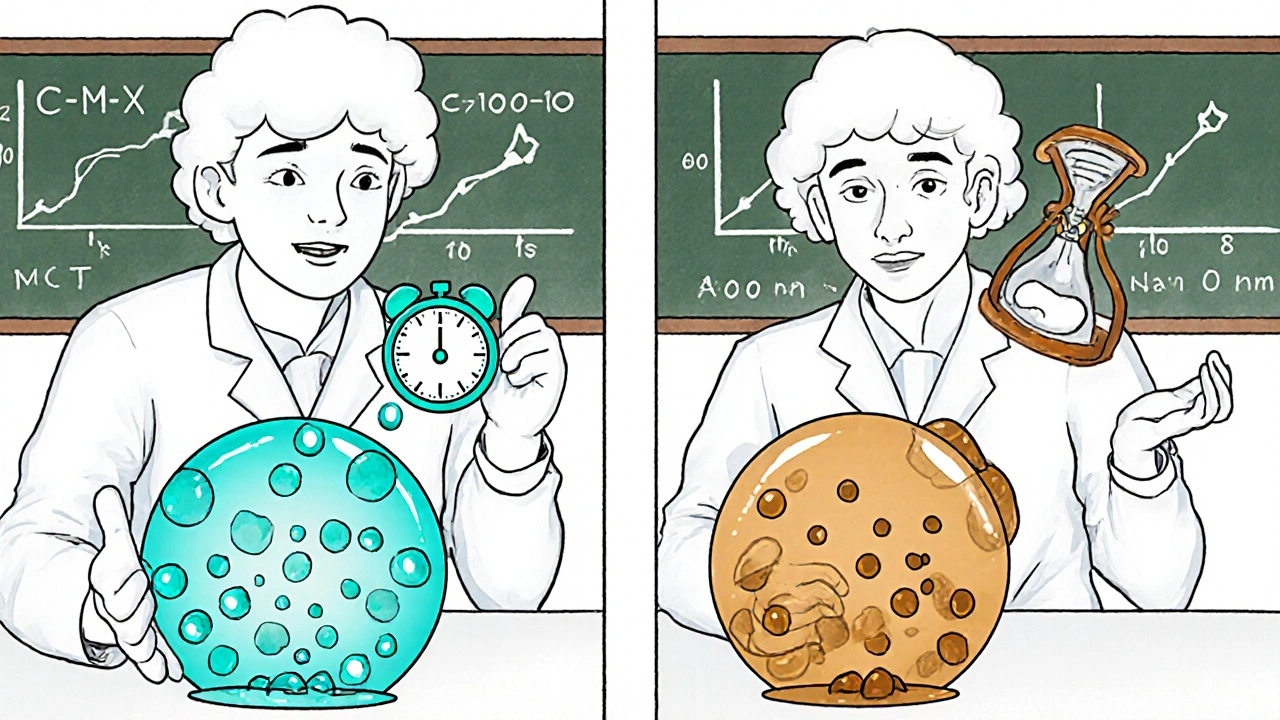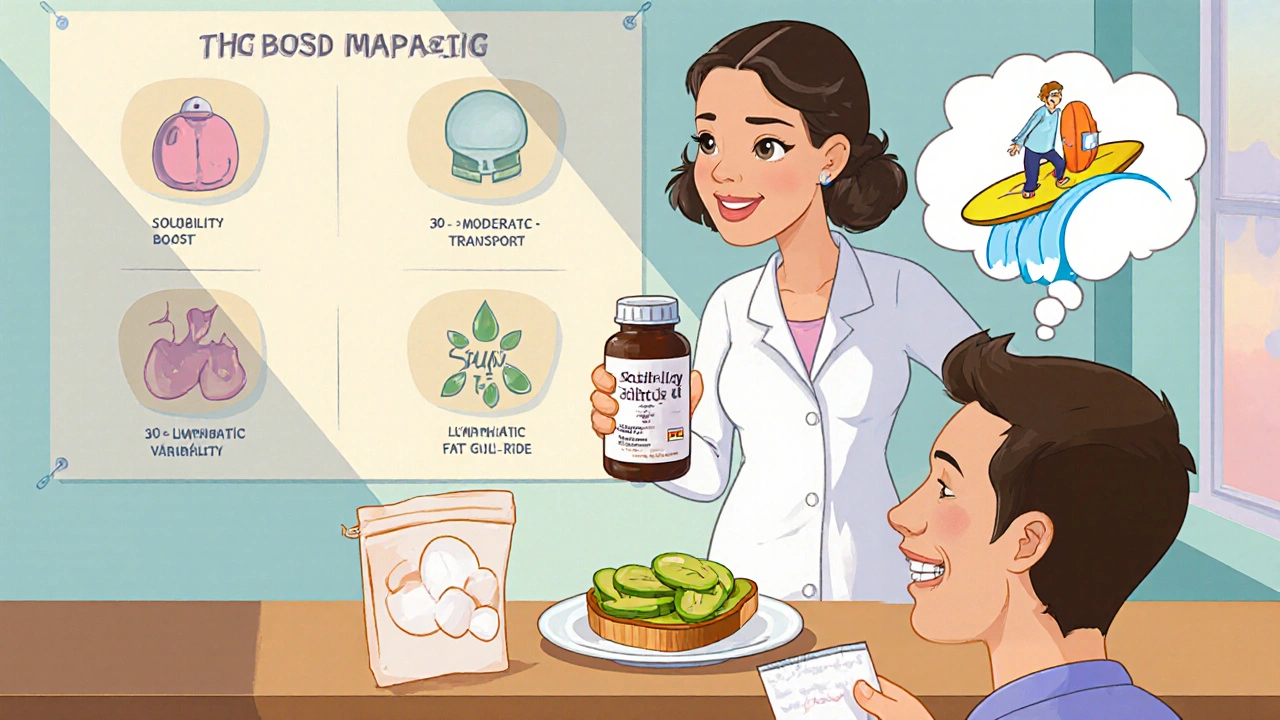Lipid Delivery Bioavailability Calculator
How Fat Improves Drug Absorption
Select your lipid type to see expected bioavailability improvements based on clinical data from Monash University research.
Choose Lipid Type
Key Parameters
Bioavailability Impact
Using Medium-Chain Triglycerides can increase drug absorption by up to 200% compared to water-based formulations. This means more of your medication reaches the bloodstream before metabolism.
Real-World Impact
Example: A 100mg dose of a BCS Class II drug using MCT-based delivery could provide bioavailability equivalent to 200mg of water-soluble formulation.
When a drug struggles to dissolve in water, Lipid-based drug delivery systems are engineered to hitch a ride on the body's natural fat‑processing pathways, dramatically boosting how much of the medication actually reaches the bloodstream. The secret? Pairing the drug with the right kind of fatty foods and a smart lipid formulation can turn a low‑bioavailability pill into a fully effective therapy.
Why the Food Effect Matters
Pharmacologists have long known that a high‑fat meal can change a drug’s pharmacokinetics - a phenomenon called the "food effect." After you eat, the stomach releases bile salts and pancreatic lipases, which break down dietary triglycerides into fatty acids and monoglycerides. These digestion products form tiny colloidal droplets that act like natural solubilizers, surrounding poorly water‑soluble compounds and keeping them dissolved long enough for absorption.
Research from Monash University showed that these colloidal structures can increase the solubility of a drug by three to five times compared with plain aqueous fluid. For drugs that fall into Biopharmaceutics Classification System (BCS) Class II or IV - low solubility, high (or low) permeability - the difference can mean a 20‑300 % jump in bioavailability.
Core Technologies Behind Lipid‑Based Formulations
The industry has converged on a handful of technologies that reliably take advantage of the food effect:
- Self‑emulsifying drug delivery systems (SEDDS) - liquid mixtures that spontaneously form nano‑emulsions (100‑300 nm droplets) when they hit gastrointestinal fluids.
- Supersaturated SEDDS (SNEDDS) - contain a higher drug load, relying on the lipid matrix to keep the drug in a metastable, dissolved state.
- Lipidic nanocapsules - solid‑core particles surrounded by a lipid shell, useful for protecting acid‑labile drugs.
All of these share a common recipe: an oil phase (30‑60 % by weight), surfactants (20‑50 %), and often a cosolvent (10‑30 %). The exact balance is tweaked based on the drug’s log P, dose, and target site.
Medium‑Chain vs. Long‑Chain Triglycerides
Not all fats are created equal. Medium‑chain triglycerides (MCTs) (C6‑C12) are hydrolyzed in the duodenum within 15‑30 minutes, while long‑chain triglycerides (LCTs) can take up to 90 minutes. Faster digestion means quicker formation of the solubilizing droplets that keep the drug in solution.
Studies comparing MCT‑rich formulations (e.g., Capmul MCM) to LCT‑rich ones (e.g., soybean oil) consistently report higher Cmax and AUC values for the former. One in‑vivo trial showed a 1.8‑fold increase in AUC for an MCT‑based SEDDS versus its LCT counterpart for a BCS II drug.
| Parameter | MCT (C6‑C12) | LCT (>C12) |
|---|---|---|
| Hydrolysis time (duodenum) | 15‑30 min | 60‑90 min |
| Typical droplet size after dispersion | 100‑200 nm | 150‑300 nm |
| Increase in Cmax (average) | 1.5‑2.0 × | 1.1‑1.4 × |
| Increase in AUC (average) | 2‑3 × | 1.3‑2 × |

Real‑World Clinical Examples
Several blockbuster drugs already use lipid‑based formulations to solve solubility problems:
- Cyclosporine - Neoral® (a lipid capsule) delivers 20‑30 % more drug than the older Sandimmune® tablet, allowing patients to skip strict food‑timing rules.
- Fenofibrate - Tricor® (SEDDS) achieves 31 % higher absorption than the non‑lipid Lopid® version, and patients report far fewer stomach complaints.
- Itraconazole - Sporanox® oral solution (a lipid suspension) provides 2.8 × the bioavailability of the capsule form, eliminating the notorious 40 % food‑effect variability.
These successes aren't just about numbers; they translate into real benefits - lower doses, fewer side‑effects, and simplified dosing schedules.
Advantages Over Traditional Solid Dosage Forms
When you stack the cards, lipid‑based systems win on several fronts:
- Solubility boost - the lipid matrix creates a reservoir that keeps the drug dissolved.
- Permeability increase - fatty acids fluidize intestinal membranes, letting more drug slip through.
- Lymphatic transport - very lipophilic drugs can bypass the liver’s first‑pass metabolism, preserving potency.
- Food‑effect mitigation - a well‑designed SEDDS can reduce variability from 40 % down to 5‑10 %.
However, the approach isn’t a universal cure. Drugs that need an acidic environment (e.g., bisphosphonates) or those with ultra‑low solubility (<1 µg/mL) may see little gain, and the formulation process adds cost and complexity.

Practical Tips for Patients and Clinicians
If you’re prescribing or taking a lipid‑based medication, keep these pointers in mind:
- Meal timing - most products work best with a moderate‑fat meal (≈30 g of fat) unless the label says “fasting.”
- Consistency - stick to the same type of meal (same fat source) to avoid day‑to‑day swings.
- Storage - many formulations are soft‑gel capsules that need protection from heat and light.
- Cost awareness - lipid products often cost 20‑40 % more than generic equivalents; check insurance coverage or patient‑assistance programs.
Clinicians should also verify that patients don’t have conditions that impair fat digestion (e.g., pancreatic insufficiency), as this can blunt the intended absorption boost.
Future Directions
Research is pushing the envelope beyond classic SEDDS. Enzyme‑triggered lipids that release the drug only when specific gut enzymes are present are entering Phase III trials (e.g., Matinas BioPharma’s LNC platform). Smart capsules that sense pH and enzyme levels in real time could personalize dosing for each patient’s digestive profile - a concept demonstrated by MIT’s "smart lipid capsule" in Science Advances (2023).
Environmental concerns are also reshaping the field. The European Federation for Pharmaceutical Sciences urges a shift toward plant‑derived lipids instead of fish‑oil or animal‑based sources, prompting formulators to explore oat‑derived triglycerides and algae oils.
All these trends point to a future where every poorly soluble drug automatically gets matched with a tailored lipid carrier, and physicians can prescribe with confidence that the food‑effect is an asset, not a headache.
Quick Checklist for Lipid‑Based Medication Use
- Confirm the product is a lipid‑based formulation (look for words like SEDDS, soft‑gel, or “oil‑based”).
- Take with a meal containing 20‑30 g of fat unless advised otherwise.
- Store according to label instructions - usually cool, dry place.
- Discuss cost and insurance coverage with your pharmacist.
- Report any gastrointestinal issues; they may signal a digestion‑related problem.
Do I need to eat a high‑fat meal for every lipid‑based drug?
Most formulations work best with a moderate‑fat meal (about 30 g of fat). Some products are designed to be taken fasting - always follow the label.
Can lipid‑based drugs cause weight gain?
The amount of fat you ingest for the drug is usually small and doesn’t affect overall calories. The drug itself doesn’t add fat to your diet.
Are there any drugs that should NOT be taken with fatty foods?
Yes. Medications that need an acidic environment, like bisphosphonates, lose effectiveness when taken with a high‑fat meal. Always check the prescribing information.
What if I have a digestive disorder that limits fat absorption?
Reduced lipolysis can blunt the absorption boost. Talk to your doctor; they may switch you to a non‑lipid formulation or adjust the dose.
How much more does a lipid‑based formulation cost?
Typically 20‑40 % higher than generic solid tablets, but the improved efficacy can offset the price by reducing dosing frequency and side‑effects.




Dawn Bengel
October 24 2025Only here in the US can we truly harness the power of fatty foods for pharma, other countries are clueless 😤. Their half‑baked attempts at lipid delivery just make me scoff.